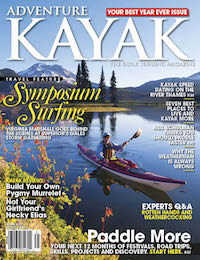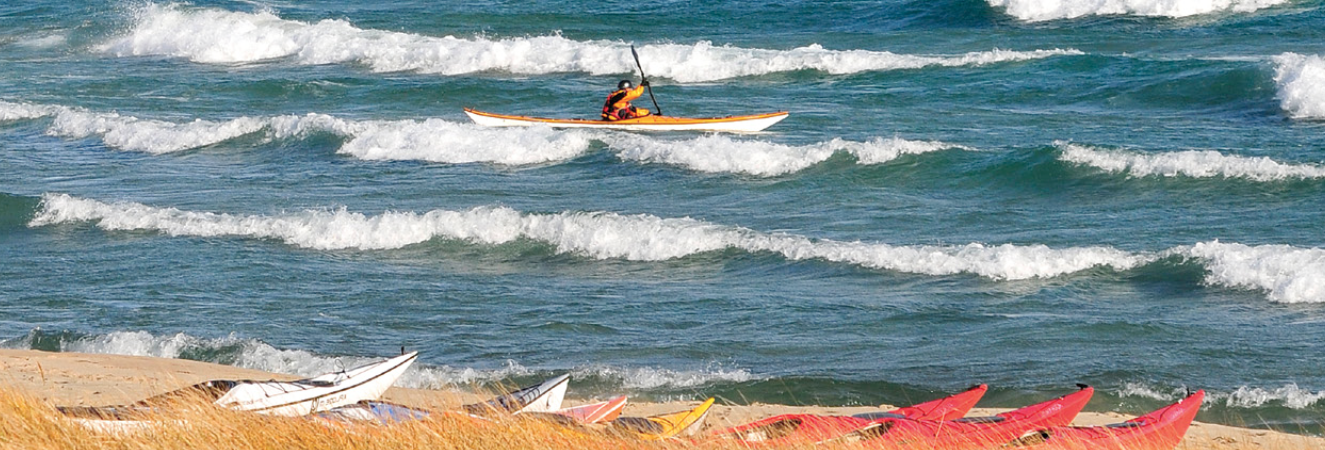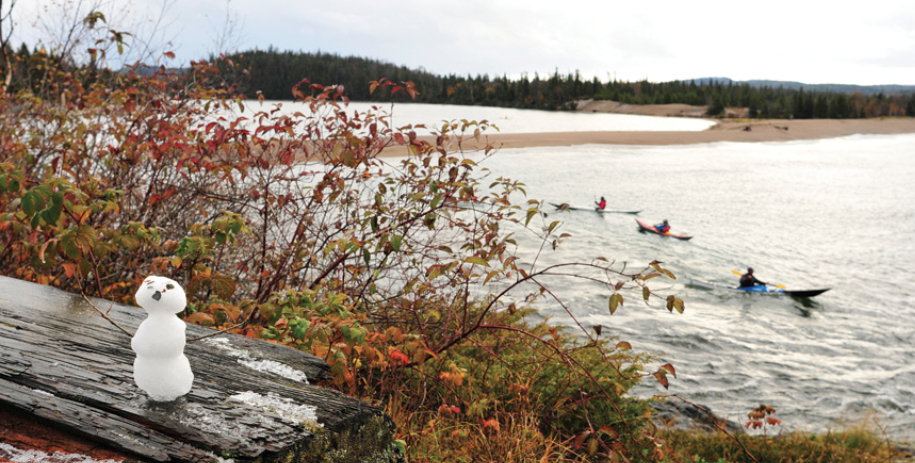At a time of the year when bitter winds and frosty mornings are driving most paddlers south to more inviting locales, a young event lures a hardy tribe north. For a restless week in the autumn of 2012, these wind chasers convened on a seven-acre point of surf-pounded rock and dumping beaches on the north shore of Lake Superior.
SECOND CLASS CITIZENS
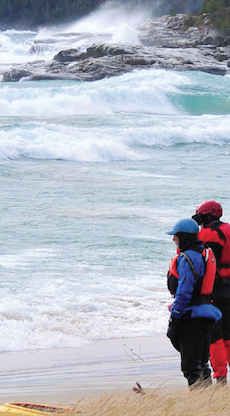
Moments later, having finished our round of class introductions—“Hi, my name is Virginia. I’m just here to watch… really, if you guys want to practice rescues and swimmer landings, I’ll just shoot photos”—we’re using paddle blades to chip ice off our seats. Lead coach Shawna Franklin demonstrates “speed launching” and invites us to follow suit. The maneuver involves shooting your empty kayak into the water, diving after it to belly flop onto the deck, and then rodeoing your butt and legs into the cock- pit whilst gliding serenely away from the beach.
Hmm, I see what you’re doing here, getting us wet now so it won’t come as such a shock later… very clever.
Still, Franklin, a BCU 5-star coach and co-owner of Body Boat Blade International in Washington’s San Juan Islands, makes the maneuver look so graceful we can’t help but try to do the same, with varying degrees of success.
It’s our second morning at the Gales Storm Gathering on Lake Superior and the weather has been typical for October: 35-knot winds, heavy swell and bone-chilling temperatures. It’s just these types of conditions that event organizers were counting on when they invited top coaches from across the U.S. and Canada and as far away as Wales to their second-annual rough-water sea kayak festival at Michipicoten Bay on the lake’s Ontario shore.
“Most symposiums are in the summer and you’re paddling on flatwater,” explains Gales co-founder Keith Wikle, a freelance instructor and GoKayakNow.com blogger from Kalamazoo, Michigan. In 2011, Wikle partnered with Ryan Rushton of Chicago’s Geneva Kayak Center and together they conceived an event where Great Lakes paddlers could train in ocean-like conditions under the supervision of top-level coaches.
“We wanted to create a venue where you can take that next step in real conditions, with a safety net so that if you do have a swim it doesn’t end up being a fatal one,” Wikle says.
The pair borrowed the event’s name from the annual Gales of November Rendezvous, a carnage- heavy rough-water gathering organized by Great Lakes sea kayaking pioneer Stan Chladek in the early 1980s. The Halloween weekend meet-up was an informal, invitational get-together based around Agawa Bay, 50 miles south of Michipicoten. In its heyday in the early ‘90s, some 50-odd expert paddlers from around the world would join Chladek for epic tours and close calls in the surf.
Now in his seventies, Chladek still gathers the troops—today a handful of old friends and local paddlers—every October 31st, but Wikle and Rushton imagined a Gales that was accessible rather than exclusive. Yes, they would still invite some of the world’s best paddlers, but they would shift the focus to coaching and open the sign-up sheet to advancing beginners and experts alike, so long as they had a thirst for Superior’s notoriously rough fall waters.
“We make it clear that you need to be into wind and waves and even snow,” says Wikle.“You’re going to be cold and wet. It’s a smaller number of paddlers who are willing to embrace that.”
The inaugural Gales Storm Gathering drew some 45 participants and 15 instructors to Superior’s south shore in Marquette, Michigan. But while the city’s inner and outer harbors and proximity to the Menominee River offered an ample variety of conditions, Wikle and Rushton always planned to move locations from year to year.
“Moving the event makes it accessible to different groups of people and showcases the tremendous variety of paddling environments on Lake Superior,” says Wikle.
“ This is a rare opportunity in this part of the world with these coaches,” agrees Alec Bloyd-Peshkin, a guest instructor from Chicago,“and the venue is a huge highlight.”
Wawa doesn’t have a paddling town vibe. A blink-and-you-miss-it community amid the North Shore’s seemingly endless cyclorama of scraggly black spruce and stoic Shield lakes, the town’s primary attractions are a giant roadside likeness of a Canada goose and the mountainous, dollar-scoops of ice cream at Young’s General Store’s mock trading post. Several dirt road miles and 350 feet downhill at Michipicoten, however, is some of the finest kayaking on Superior.
Rushton and Wikle found a keen partner in David Wells, owner of local sea kayaking outfitter Naturally Superior Adventures and 2012 Gales host, Rock Island Lodge. Situated at the mouth of the mighty Michipicoten River, Rock Island is wreathed in the often-turbid waters of one of the lake’s largest tributaries. Here, three-mile-per-hour currents collide with autumn swells reaching 10 feet or more, born from the longest fetch on Superior—nearly 350 miles to Duluth. The site promised just the sort of ocean-like exposure and challenging conditions the organizers wanted to showcase when they invited their coastal comrades to the Inland Sea.
“We often feel like second-class citizens because we’re on freshwater,” Wikle says,“But the Michipicoten has enough current to create tidal race conditions. That’s the Lake Superior we want to show off, especially to paddlers from the coast.”
Along with Franklin and Body Boat Blade partner Leon Sommé, headline instructors at Gales 2012 included Wales’ Nick Cunliffe, Halifax’s Christopher Lockyer, BCU senior coach Scott Fairty and around-Ireland paddler Sam Crowley. “ These are the leaders in our community,” says Wells. “Of course we have something to prove.”
“WHAT KIND OF FLOWERS DO YOU WANT AT YOUR FUNERAL?”
Michipicoten is a long drive from anywhere. I roll down the narrow causeway onto Rock Island at dusk after a full day behind the wheel. Beyond my passenger window the surf dumps explosively on the steep gravel of Government Beach. Out the driver’s side, even the sheltered bay just inside the river mouth is tossed with whitecaps. I drive past a line of tents clinging tenuously to the beach, park behind a windbreak of twisted cedar, throw my sleeping bag in the back of my van and fall into dreams of being blown out to sea on a Therm-a-Rest.
I’m grateful for a slow start the following morning. Gale-force winds have stymied the morning workshops and the final evaluations for the score of participants who signed up for a pre-symposium coaching week. After four days of drilling, they gather in the lodge around the warmth of a roaring fire, content to merely watch a frenzy of white horses galloping across Michipicoten Bay as the wind tosses horizontal sheets of rain against the windowpanes.
Conversation circles from the weather, the schedule and the best gear to anxieties about their impending assessment. Inevitably, there’s some light-hearted jesting. “Are you ready for the night navigation exercise tonight?” Steve asks Tammy as 11-foot breakers thunder up the river mouth. Without missing a beat, Tammy retorts, “ What kind of flowers do you want at your funeral?”
A petite woman in her late sixties, Tammy took up paddling after retirement and is now a sea kayaking junkie. She drives all over the East to train with many of the sport’s best coaches. After eight days of Gales, she’s heading down to Georgia’s Tybee Island for a week of Greenland-style instruction, and then pushing into South Carolina for several days of private coaching with Scotland’s Gordon Brown. Tammy’s paddling knowledge now extends well beyond strokes and rescues; she can also tell you the strengths and weaknesses of a regular who’s who of top kayaking brass.
It’s the calibre of the instructor roster, she tells me, that drew her to Gales. The event brings together instructors from BCU, ACA and Paddle Canada doctrines, allowing participants to sample the field. “It’s wonderful to be exposed to so many different instructional styles,” Tammy says. She describes BCU coaching week lead, Nick Cunliffe, as “an amazing instructor with really helpful feedback,” a senti- ment echoed by many of the other Gales students about their respective coaches.
Okay, so it’s a privilege to be under the wing of such accomplished paddlers and teachers. But as we gather on the rocks at the river mouth to watch Cunliffe and Sam Crowley, owner of Michigan-based Sea Kayak Specialists, poke their bows into a 40-knot s’wester, I wonder if part of the attraction is in witnessing the masters made mortal.
As Cunliffe and Crowley edge further and further into the crashing waves, Steve calls a play-by-play commentary: “Oh, Sam is out of his boat!” he yells when Crowley pushes too far and is caught between an avalanching set and the steep face of surf-washed beach. Moments later, he’s crowing, “Now I don’t feel so bad!” as a soggy Crowley staggers ashore sans kayak.
A SOCIAL VENUE
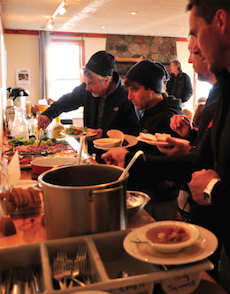
With the wind still gusting to well over 30 knots, the river mouth remains a no-paddle zone. Most head upriver for workshops on paddling in current, maneuvering in wind and waves, and practicing advanced rescues, while a handful of keeners convoy to nearby Sandy Beach for a surfing lesson. With its long, shallow approach, Sandy is a “spilling” beach—the waves break gradually, dispersing their energy as they roll ashore—making it a more forgiving training ground. Even so, with the intense onshore wind, students and coaches alike are soon exhausted. It takes every last ounce of effort to merely hold position in the shore wash, let alone punch out through the breakers. Spinning a 16- or 17-foot craft 180 degrees to surf back in is all but impossible.
Eventually, a couple of participants abandon their boats on the sand in favor of body surfing. Like a massive heat sink, Lake Superior maintains its summer temperature well into the fall, making the famously cold lake feel comparably balmy on bracing autumn days. In drysuits, we discover, being in the water is more comfortable than being on it. Before long, the whole class is belly flopping into the surf, our unflappable coaches leading the charge.
Like the animated scene in the dining room earlier, the impromptu body surfing session demonstrates that Gales is as much a social venue as it is a place to hone rough-water skills.
By day two the wind has abated to a manageable 10–15 knots and the coaches are able to move their classes out into the bay. While I’m watching Franklin speed launch, Wells wanders over. Gazing across the frozen beach at the colorful clusters of shivering figures and rime-crusted boats, he marvels, “Look how many people are on the water in sub-zero temperatures—it’s frickin’ awesome!”
Tracing a coastline of long, gravel beaches and billion-year-old bedrock points, Franklin leads our group through a progression of landing and launching exercises. Then it’s the students’ turn. Franklin asks Susan —the Ann Arbor, Michigan, paddler whose mistake, it turned out, was clicking ‘Register Now’ on the Gales website before she had all the facts—and two others, Tom and Sue, to direct an “emergency” group landing on an inhospitable, rocky spit exposed to the swell.
So far we’ve excelled as students, but it quickly becomes apparent that our leadership needs some work. A confident and capable paddler from Minneapolis, Sue doesn’t think there’s a safely manageable landing for a group on the point. Tom, a local in his mid-forties, disagrees but doesn’t want to be the first to land—inexplicably, he suggests Sue lead the assault. Meanwhile, Susan says little—later she’ll tell us she felt excluded by her co-leaders.
We bob around in the unsettled waters for what feels like an eternity, our designated leaders mired in indecision. Finally, Franklin tosses them a lifeline,“You could ask your group to help, and send one of your strongest students in first to land the others… you can send me if you like.”
Franklin sidles up to the rocks and steps nimbly onto a sliver of ledge, timing her exit with the surging rise and sucking fall of the waves against the smooth-polished stone. Sue lands next and suddenly our leaders are working together—if not a well-oiled machine, at least one that is no longer seized.
By evening, snowflakes are filling the air. We carpool into Wawa for dinner, heaters blasting as we bounce up the potholed track away from the lake. Dashing across the parking lot beneath the wall-eyed gaze of the Wawa Motor Inn’s 15-foot rooftop goose, we escape the flurries in the restaurant’s warm, woodsy sanctuary.
Over a basket of the Motor’s famous wings (chicken, not goose), Jeff, one of the coaching week students, fills me in on his assessment.“I worked really, really hard to learn I can stay [at the certification level] where I’m at,” he confesses. Jeff and his wife Michelle drove from Minneapolis to be at Gales, but he isn’t angry or even disappointed with this outcome.“Sam and Ryan didn’t just say ‘nope, you’re not good enough,’” Jeff says of his coaches. “ They gave me honest, useful, realistic feedback so I came away with a list of areas for improvement—somewhere to go from here.”
MEMBERS OF AN ELITE TRIBE

Eavesdropping on the coaches’ discussion, I can see that this group— even with their tremendous cumulative skills and experience—is grappling with the same challenges as yesterday’s student leaders. The same challenges faced by all kayakers: complex environments and decisions, fatigue and uncertainty.
Wikle tells me later that, even more than the curveballs thrown by the weather, the skill level of the participants has surprised his guest coaches. “I’m told it’s quite high compared to other parts of the country,” he says,“it seems Great Lakes kayakers take developing skills and seamanship more seriously than many of their counterparts on the West Coast.”
Later that afternoon, the current flooding out of the river mouth pushes against the incoming swell, forming steep glassy rollers. The conditions are fleeting, with the wind returning before long, but it’s time enough for many of us to sample rough-water paddling at its rollicking best. Eager to catch long, cruisy surfs for ourselves, we crowd close together in the line-up—the area just outside where the waves begin to break.
Rushton takes off on a wave and I catch a steepening face just behind him. Accelerating into the trough ahead as the wave breaks, my kayak broaches and suddenly I’m side surfing—an out-of-control, Hail Mary move known as a bongo slide in surf parlance. Rushton’s ride has already ended and I’m sweeping towards him, pushed by the freight-training wave at an alarming speed. He looks up and we lock eyes— each seeing that I’m about to steamroll over him. Then, at the last possible moment, my bow veers back down-wave and I carve away, missing his boat by a few scant feet. When I see Rushton later in the line-up, he’s smiling,“There’s nothing like when your eyes meet on a wave.”
Riding waves with our mentors is both liberating and uniting.“An ‘aha!’ moment,” as Mark, a soft-spoken retiree and first-time surfer from Washburn, Wisconsin, puts it later.
After dinner, the lodge’s dining room is cleared for slideshow presentations. Local instructor and author Conor Mihell reads a chapter from his book The Greatest Lake, a history lesson on Chladek’s original Gales, accompanied by archival photos from those early years. Mihell pauses frequently for appreciative “oohs” and “ahs” from the audience as slides of cartwheeling kayaks appear on the screen behind him. We’re now members of the same elite tribe.
A FRESH AND QUIET CONFIDENCE
Gathering for Wikle and Rushton’s event wrap-up Monday afternoon, we are tired and stiff-limbed. But there’s something else engraved in the weary visages—a fresh, quiet confidence that wasn’t there before.
Most of us have tripped on the Michipicoten’s fickle currents, or wiped sand from our ears and eyes when the fleeting union of wave and kayak eluded us. But we have also learned the unforgettable, inimitable sensation of harnessing that power and riding a peeling left all the way to the beach, of rolling effortlessly on a pillowy foam pile. Of being soggy and tired and heading back out for one more ride.
Before we part ways, Tammy tells me a story. She met a young woman this weekend, a recent inductee into the paddling community. The woman told Tammy that, contrary to the opinions of non-paddling friends back home, she didn’t believe she was addicted to kayaking. She pulled on a wool hat as she spoke, finished dressing for a rough-water rescues workshop. The lodge’s thermometer read 23 degrees Fahrenheit.“If you’re going out today,” Tammy told her,“then you’re addicted to kayaking.”
